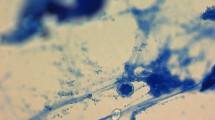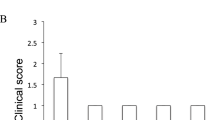Abstract
A review of consecutive cases of Acanthamoeba keratitis presenting since 1984 was undertaken in order to assess prognostic factors, the success of culture procedures and the outcome of medical and surgical management, with reference to current clinical practice. Seventy-two consecutive cases (77 eyes) of Acanthamoeba keratitis have been managed. Sixty-four patients were contact lens wearers, 28 of these wearing disposable lenses. Superficial corneal involvement and perineural infiltrates were common in those diagnosed less than a month after first symptoms, designated ‘early’ presentation. Ring infiltrates and ulceration with stromal lysis characterised those presenting at 1-2 months (‘intermediate’) or after 2 months (‘late’); these groups also progressed more frequently to hypopyon, scleritis, glaucoma and cataract formation. Positive corneal cultures were obtained in 10 of 14 (71%) intermediate and 17 of 23 (74%) late cases; early cases underwent epithelial biopsy but formal trephine biopsy was not usually justified (1 of 35 cases) and only 19 of 35 (54%) were tissue-positive. Microbial co-isolates were obtained from 20 corneas. Thirty-four penetrating keratoplasties were performed in 23 eyes, 21 whilst inflamed and 13 when quiet. Of 13 failures in inflamed eyes, 9 were due to recurrence of Acanthamoeba infection. Medical cure is known to have been achieved in 64 of 73 (88%) eyes, 4 of the original 77 having been lost to follow-up abroad. Fifty-eight of 73 eyes (79%) achieved a final visual acuity of 6/12, and of the culture-positive cases, 32 of 46 (70%) achieved 6/12. Since 1984 an effective biguanide-propamidine treatment combination has been introduced, cases have been diagnosed increasingly early and consequently the time taken for medical cure has decreased. The prognosis of this potentially blinding keratitis has improved due to heightened clinical suspicion resulting in early diagnosis, a rigorous scheme of investigation and proven management strategies.
Similar content being viewed by others
Article PDF
References
Berger ST, Mondino BJ, Hoft RH, Donzis PB, Holland GN, Farley MK, Levenson JE . Successful medical management of Acanthamoeba keratitis. Am J Ophthalmol 1990;110:395–403.
Moore MB, McCulley JP . Acanthamoeba keratitis associated with contact lenses: six consecutive cases of successful management. Br J Ophthalmol 1989;73:271–5.
Lindquist TD, Sher NA, Doughman DJ . Clinical signs and medical therapy of early Acanthamoeba keratitis. Arch Ophthalmol 1988;106:73–7.
Moore MB, McCulley JP, Kaufman HE, Robin JB . Radial keratoneuritis as a presenting sign in Acanthamoeba keratitis. Ophthalmology 1986;93:1310–5.
Tripathi RC, Monninger RHG, Tripathi BJ . Contact-lens associated Acanthamoeba keratitis: a report from the USA. Fortschr Ophthalmol 1989;86:67–71.
Bacon AS, Dart JKG, Ficker LA, Matheson M, Wright P . Acanthamoeba keratitis: the value of early diagnosis. Ophthalmology 1993;100:1238–13.
John T, Lin J, Sahm D, Rockey JH . Effects of corticosteroids in experimental Acanthamoeba keratitis. Rev Infect Dis 1991;13s:s440–2.
Ficker L, Seal D, Warhurst D, Wright P . Acanthamoeba keratitis: resistance to medical therapy. Eye 1990;4:835–8.
Osato MS, Robinson NM, Wilhelmus KR, Jones DB . In vitro evaluation of antimicrobial compounds for cysticidal activity against Acanthamoeba. Rev Infect Dis 1991;13s:s431–5.
Cohen EJ, Parlato CJ, Arentsen JJ, Genvert GI, Eagle RC, Wieland MR, Laibson PR . Medical and surgical treatment of Acanthamoeba keratitis. Am J Ophthalmol 1987;103:615–25.
McLellan K, Coster DJ . Acanthamoebic keratitis diagnosed by paracentesis and biopsy and treated with propamidine. Br J Ophthalmol 1989;71:734–6.
Ficker LA . Acanthamoeba keratitis: the quest for a best prognosis. Eye 1988;2(Suppl):S37–45.
Silvany RE, Luckenbach MW, Moore MB . Paraffin-embedded sections of corneal tissue with calcofluor white. Arch Ophthalmol 1987;105:1336–7.
Robin JB, Chan R, Rao NA, Sharma S, Srinivasan M . Fluorescein-conjungated lectin visualisation of fungi and Acanthamoeba in infectious keratitis. Ophthalmology 1989;96:1198–1202.
Larkin DFP, Kilvington S, Dart JKG . Treatment of Acanthamoeba keratitis with polyhexamethylene biguanide. Ophthalmology 1992;99:185–91.
Stapleton F, Dart JKG, Minassian D . Nonulcerative complications of contact lens wear: relative risks for different lens types. Arch Ophthalmol 1992;110:1601–6.
Devonshire P, Munro FA, Abernethy C, Clark BJ . Microbial contamination of contact lens cases in the west of Scotland. Br J Ophthalmol 1993;77:41–5.
Feist R, Sugar J, Tesler H . Radial keratoneuritis in Pseudomonas keratitis. Arch Ophthalmol 1991;109:774–5.
Larkin DF, Kilvington S, Easty DL . Contamination of contact lens storage cases by Acanthamoeba and bacteria. Br J Ophthalmol 1990;74:133–5.
Larkin DFP, Easty DL . External eye flora as a nutrient source for Acanthamoeba. Graefes Arch Clin Exp Ophthalmol 1990;228:458–60.
Elder MJ, Kilvington S, Dart JKG . A clinicopathological study of in vitro sensitivity testing and Acanthamoeba keratitis. Invest Ophthalmol Vis Sci (in press).
Johns KJ, Head WS, O'Day DM . Corneal toxicity of propamidine. Arch Ophthalmol 1988;106:68–9.
Kirkness C, Adams GGW, Duly PN, Lee JP . Botulinum toxin A-induced protective ptosis in corneal disease. Ophthalmology 1988;95:473–80.
Holland GN, Donzis PB . Rapid resolution of early Acanthamoeba keratitis after epithelial debridement (letter). Am J Ophthalmol 1987;104:87–9.
Ishibashi Y, Matsumoto Y, Kabata T, Watanabe R, Hommura S, Yasuraoka K, Ishii K . Oral itraconazole and topical miconazole for Acanthamoeba keratitis. Am J Ophthalmol 1990;109:121–6.
Ficker LA, Kirkness C, Wright P . Prognosis for keratoplasty in Acanthamoeba keratitis. Ophthalmology 1993;100:105–10.
Kirkness C, Aitken D, Gavin M, Hay J, Lee W, Seal D . Valkampfid keratitis simulating Acanthamoeba infection associated with disposable contact lens wear (an overlooked diagnosis?). Invest Ophthalmol Vis Sci 1993;34(ARVO Suppl):853.
Author information
Authors and Affiliations
Rights and permissions
About this article
Cite this article
Bacon, A., Frazer, D., Dart, J. et al. A review of 72 consecutive cases of Acanthamoeba keratitis, 1984–1992. Eye 7, 719–725 (1993). https://doi.org/10.1038/eye.1993.168
Issue Date:
DOI: https://doi.org/10.1038/eye.1993.168
This article is cited by
-
The role of the calcofluor white staining in the diagnosis of Acanthamoeba keratitis
Journal of Ophthalmic Inflammation and Infection (2023)
-
Impact of implementation of polymerase chain reaction on diagnosis, treatment, and clinical course of Acanthamoeba keratitis
Graefe's Archive for Clinical and Experimental Ophthalmology (2023)
-
Update on the Management of Acanthamoeba Keratitis
Current Ophthalmology Reports (2022)
-
Clinical features and serial changes of Acanthamoeba keratitis: an in vivo confocal microscopy study
Eye (2020)
-
Acanthamoeba keratitis in Australia: demographics, associated factors, presentation and outcomes: a 15-year case review
Eye (2020)



